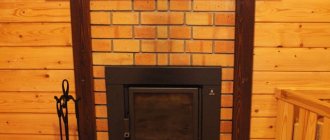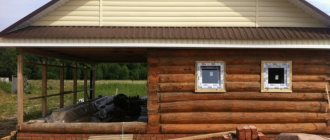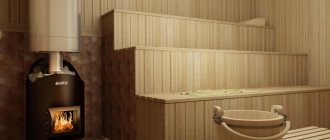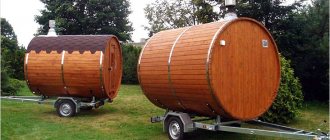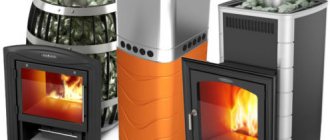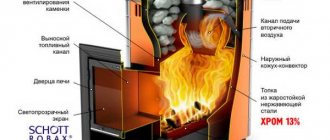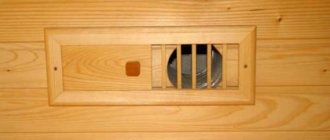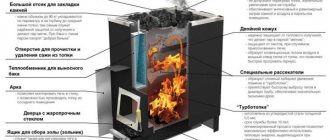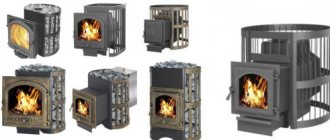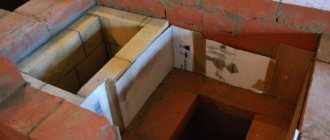- home
- Articles
- Insulation for a bathhouse - choosing the best
In order for the bathhouse to be functional and comfortable, you should take care of its arrangement in advance. For finishing and insulating buildings, only high-quality materials are purchased; otherwise, repair work will have to be carried out frequently. But what material should you choose to insulate a bathhouse yourself or with the help of experts?
- Choosing the right insulation: review of materials Foil/Foil paper
- Mineral wool/mineral board
- Polyethylene film
- Polypropylene (PP) film
- Fiberglass insulation
- Polyethylene foam (PPE)
- Expanded polystyrene concrete (PSB)
- Expanded polystyrene (PPS)
Rules
Electrical wiring in a bathhouse is naturally different from wiring in a residential building. The room closest to the requirements is the bathroom. It also has high humidity , but the temperatures, of course, are different.
However, even in a bathhouse, not all rooms are equally problematic from an electrician’s point of view. So we would call the steam room and washing room the most “problematic”. The rest room, dressing room, bathroom and veranda do not require increased protection of wiring and devices.
Once we have already made detailed excerpts from the PUE, which mention baths, saunas or washrooms. Therefore, now we will limit ourselves to a rather condensed retelling of the rules for electrical wiring in a bathhouse.
Let's start with the location of the electrical panel. It is advisable to place it indoors and not outdoors. In this case, it is necessary to either use a dry room or ensure complete waterproofing of the shield. No pipelines (water supply, gas pipeline, sewerage) should pass near the switchboard.
the installation of an RCD is considered mandatory for wet rooms.
Wires should be led:
- (preferably, not necessarily) hidden in the steam room and washing room;
- open on the wooden walls of other rooms.
IMPORTANT! However, it should be remembered that in a steam room it is not advisable to run wires along the walls, even inside. The right thing to do is to make a through hole with a metal sleeve in the wall, through which the wires for the lamp go into the steam room.
The wires leading to the steam room must be made heat-resistant - with insulation made of silicone rubber - RKGM, PRKS.
The ban on metal sleeves and corrugation applies only to steam rooms and washing rooms.
Wires can only by welding, crimping, soldering or a similar method.
Switches and sockets should be located outside the steam room and washing room.
complete list of rules for wiring in a bathhouse and steam room at the link already given above.
What are the benefits of polymer insulation? Their disadvantages
For thermal insulation of baths and saunas, polymer and mineral insulators are mainly used. Let's start with the first ones.
By polymeric materials we mean polystyrene foam, extruded polystyrene foam and polyurethane foam.
Polyfoam is suitable for insulating external walls and floors. Available in the form of lightweight slabs of different sizes, differing in thickness. It is affordable, maintains its integrity in a humid environment, and does not cause any hassle in processing.
Extruded polystyrene foam is an improved version of conventional polystyrene foam, superior in density and thermal conductivity.
Polyurethane foam is distributed in the form of a liquid, which is sprayed over the object using special equipment. This creates a reliable insulating coating with excellent heat and sound insulation properties.
However, all these solutions have one significant drawback in common - they are flammable and can release toxic substances when heated. That is why they are used for external thermal protection.
For internal installation, slabs or mats made of basalt fiber have proven themselves to be effective.
Electricity in the bathhouse: consumer groups
Consumer groups are arbitrary groups of devices that are powered by current. They are arbitrary because it depends on your choice (or on the choice of an electrician) on what basis you will group devices.
There are two options:
- or group by room - all consumers of a relaxation room, steam room, washing room, for example;
- or by uniformity - all sockets, all lamps, all power plants.
ADVICE! Mark the names of consumer groups using labels attached to the wires and labeled.
In our diagrams you will find a division into the following groups: lamps, sockets and power units.
Let us explain that the last group includes devices with high electricity consumption. In the bathhouse these are most often electric ovens and washing machines.
Laying stones in an electric heater
An electric heater is a container inside which heating elements ( tubular electric heaters) . They are located at a certain distance from each other, which allows installation between individual heating elements.
IMPORTANT! Never turn on the electric heater without filler.
The main difference between filling an electric heater is the size of the fractions. A relatively small fraction is taken, somewhere around 4-7 centimeters on the larger side. The stones are placed between the heating elements in such a way that there is always a small space between them, as well as between them and the heating elements.
IMPORTANT! Do not overdo it - heating elements cannot be distorted, bent, or changed the distance between them. Therefore, the pebbles always rest only on each other.
If you place the filler too tightly, the heating elements will not be able to give off heat as they should, so they will go out of the passport heating mode. And elements that regularly overheat will fail before their average service life. In addition, dense packing increases the heating time of the bath. And yet, the last layer of stones should completely cover the heating elements that do not reach the side of the electric heater.
Here the stones are somewhat large for this stove and it doesn’t make sense that they stick out so high on top, the tops won’t warm up anyway
IMPORTANT! There should be no more than 7-8 cm from the heating elements to the top edge of the filler.
By the way, the installation order is no different from that mentioned above:
- sort the stones into batches of the same size;
- Place the larger ones down.
Weigh the filler and compare the weight with that recommended in the electric heater’s data sheet. You should know that both overload and underload are equally unacceptable.
IMPORTANT! When starting operations with stones, remember that it is better to hold the heating elements with your hand.
It is worth going through the contents of the heater in such a stove 1 or 2 times a year to get rid of dust and broken stones - cracked, broken into pieces.
Useful video
Video on the topic: a visual demonstration of how to properly place stones in an electric heater.
Wiring: what does it consist of?
The main electrical wiring components in a bathhouse are the following:
- input cable;
- electrical panel;
- grounding;
- indoor cables;
- lamps;
- sockets
- Inside the electrical panel there are the following elements: cables;
- tires;
- RCD;
- circuit breakers;
- differential automatic machines;
- transformer.
The input cable can have 3 or 5 cores , and transmit current with a voltage of 220 or 380 volts.
ATTENTION! Grounding is required. Read about how to do it here.
You will find information about what parameters the components must meet in the same article.
There is a difference in a bathhouse and a steam room
We have already said above that the wiring in the steam room differs in a number of important points from the electrical wiring in the bathhouse.
ADVICE! It will be easiest for those bathhouse owners who already included the wiring in the construction project. Because this is the only way compliance with standards will not be a matter of chance.
In the steam room
Electrical wiring in the steam room: no wires
there are no wires - they go from the outside, and go inside exclusively to connect the lamps.
The question arises: is it necessary to use more expensive heat-resistant wires for electrical wiring in the steam room of a bathhouse? For those who have no way out and have to conduct wiring inside the walls of the steam room - yes, definitely. If you follow the rules - only through the wall to the lamp, then it is a matter of ease of replacing the wire.
The fact is that simple PVC insulation will inevitably collapse in the area that is exposed to high temperatures . This is usually at the wire entrance to the lamp. Therefore, it is recommended to make this area heat-resistant.
In a steam room with an electric oven
The electric furnace is used only in the sauna (because we question the ability of electric furnaces without a steam generator to create a Russian bath mode).
Power calculations are usually done in a simplified manner, based on the cubic capacity of the room, based on the ratio of 1-1.5 kilowatts per cubic meter. Therefore, it is enough for you to proceed from one or one and a half volume of the steam room. Let's assume that a pair room of 1.8*1.4*2.1 (DSHV) is given. Its volume is 5.3 cubic meters. Consequently, the furnace power is from 5 to 8 kW. And this is still a small steam room!
It is clear that such a power plant is not installed on a regular outlet (here the current strength is 23-36 A, and a regular outlet can withstand 10-16 A). The wire is led outside and connected to a power outlet (they come in different capacities).
Heat-resistant wires of the required cross-section are included with the stove itself , so you just need to take them out and connect them.
BY THE WAY! A grounding plug requires a ground connection to the outlet, this is not new, is it?
